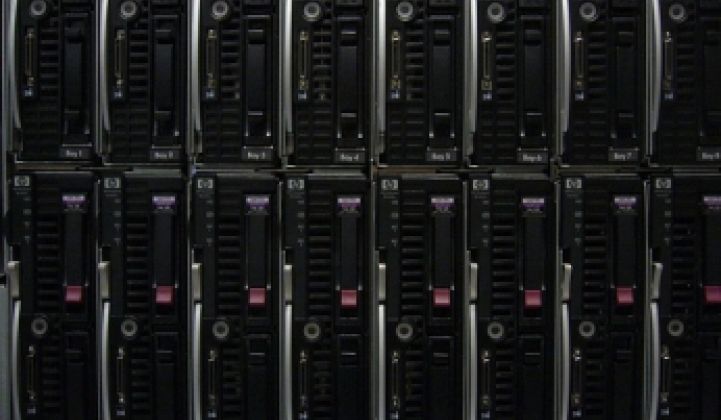Pacific Gas & Electric has added energy efficient data storage – specifically thin provisioning and massive array of idled disks, or MAID, storage – to the host of technologies that can earn data centers some hefty rebates.
Next on the PG&E's list of data center efficiencies – thermal energy storage, or using cheap nighttime power to chill water or make ice to cool data centers during the day.
The Northern California utility has given out about $20 million since 2006 to encourage data centers to get more efficient, starting with better cooling and power supply systems and moving on to virtualization and more efficient servers (see PG&E Wants To Give Away More Money, See Fewer Email Attachments).
Storage has been its next technology to tackle, said Mark Bramfitt, principal program manager in PG&E's energy efficiency group. Think of it as a way to reach into the past to squeeze out efficiencies. After all, while overall data center growth might ebb and flow according to the economy's dictates, the amount of stored data continues to grow.
Data centers use up about 2.5 percent of the power in Northern California, compared to about 1.5 percent nationwide (see Data Centers Could Hit 'Resource Crisis').
While it's hard to estimate what share of that is taken up by storage, estimates of 50 percent growth every year may be too low, Bramfitt said.
The other thing that makes storage a good target is that "equipment is vastly over-capacity for the work they need to do," he said. Data center operators would rather play it safe and provision way too much storage than be caught without it, he said.
"Thin provisioning" is the term used to describe doing away with that unnecessary extra storage, and it can earn PG&E customers rebates, Bramfitt said.
Or, maybe they can just idle the storage disks until they're needed. That's the idea behind massive array of idled disks (MAID) systems, which in essence means that the storage disks remain off until you need them to recover data.
That's obviously a lot more energy efficient than leaving them on all the time, but comes at a cost of having to wait around for them to get spinning, which causes latency issues.
It's given MAID systems somewhat of a bad reputation in the industry, said Bob Woolery, senior marketing director for Nexsan.
But the Thousand Oaks, Calif.-based storage device maker gets around that problem with its AutoMAID technology, which allows customers to pre-set how much energy they want to save versus how fast they want to be able to retrieve data, he said.
That can range from 20 percent energy savings for "sub-second" retrieval time, to up to 70 percent energy savings if you're willing to wait up to 45 seconds.
While educating data center operators about these differences from previous MAID systems has been challenging, those data centers are also far more interested in saving power than they used to be, he said.
"The question that drives most people either they have a power challenge, or they're trying to reduce the cost of running their facility," he said. While driving down power bills is one thing, some data centers simply can't grow any more power hungry because the utility can't bring in any more power (see GE Looks to Data Center Efficiency)
Another MAID vendor that has earned PG&E rebates is Copan Systems, and others are likely to emerge, Bramfitt said – PG&E doesn't certify vendors' products for rebates, so to speak, but rather verifies that specific installations are saving the energy they claim, then uses those examples to guide future rebate programs in consultation with data center customers.
But when it comes to solving another power-wasting data storage technique – storing multiple duplicates of data and taking up disk space that could be put to other uses or idled – PG&E will have a harder time paying rebates, Bramfitt said.
De-duplicating such redundant data can save from 20 percent to 80 percent on energy bills in a one-off fashion, as all the duplicate data from the past is done away with, and can also save energy going forward (see Green Light post).
But given the wide range in potential savings, "I just can't pin a kilowatt-hour on such a large spread," Bramfitt said. "We still think it's a great technology."
What's next for PG&E's data center rebate program?
"We're certainly talking to the flash memory folks, and those who'd like to see a revival of optical disks rather than tape," Bramfitt said.
Beyond that, he'd like to start developing incentives for what he calls "thermal energy storage," which is using cheap nighttime power (and cool temperatures) to chill water, or even freeze it.
Cold water or ice can then be harnessed to make data center cooling systems more energy efficient during hot summer afternoons, which coincidentally align with when the utility faces its peak power demands, he noted (see Green Light post).
That opens data centers to potentially taking part in so-called demand response programs, in which big power users are paid to dial down their power use during peak load times, to help the utility avoid blackouts or turn to expensive emergency power generation sources, Bramfitt said.
Ice Energy, which makes ice-making air conditioning systems, is already seeking utility customers interested in footing the bill for installing its systems for such peak shaving uses. Data centers could be a big target for that (see Will Utilities Pay For AC Upgrades?).
Image via skreuzer / Creative Commons



